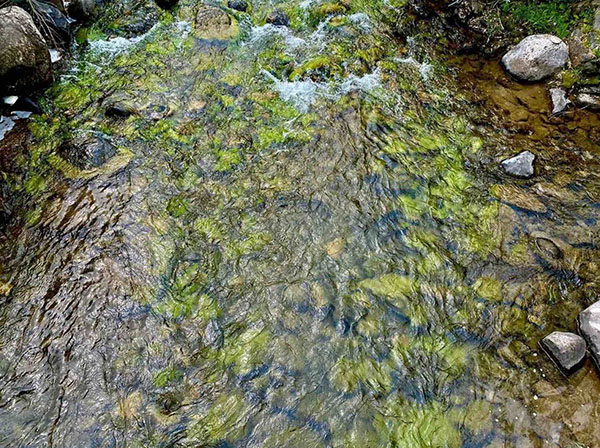As you’ve likely noticed, a wide-spread, bright green algae bloom yet again took over our backyard waterway. From the upper reaches of the Taylor Fork to downstream of Portal Creek, filamentous vegetation covered the river-bottom rocks.
At first glance, the algae is almost beautiful, looking more like a tropical coral than an aquatic agitator. But in this case, looks are deceiving and its presence is anything but welcoming.
Cladophora, the primary algae of concern in the upper Gallatin watershed, is naturally occurring. Its growth is driven by several factors, including nitrogen and phosphorus levels, water clarity, water temperature, available sunlight, pH, water velocity and water hardness. What the Gallatin River Task Force is working to better understand is why these growth drivers are suddenly leading to more wide-spread blooms, how much these blooms are being caused by human land use and what we need to do as a community to solve the problem.
“We could be seeing an imbalance on multiple fronts,” said Chace Bell, water quality monitoring and assessment specialist with the Montana Department of Environmental Quality. “We’re in the so-called Goldilocks zone,” he continued, where conditions are just right for wide-spread, nuisance growth.
“So far, in high-gradient, fast-moving rivers [like the Gallatin], the blooms aren’t severe enough to affect fish populations in one summer, but we could start to see a macroinvertebrate shift over time,” Bell said. To avoid that and other negative outcomes, “we need to be creative in building resiliency,” he continued. “There’s a tremendous amount of complexity when trying to come up with management plans and solutions because of non-point sources.”
Non-point sources are pollutants that originate not where the effect is seen in the river, but elsewhere in the watershed. For example, stormwater tainted with chemicals from fertilizer flows from a driveway in a Big Sky housing development to our underground aquifers before resurfacing somewhere downstream—say near the Deer Creek fishing access. When this polluted groundwater re-enters surface waters like the Gallatin River, it could still contain high enough levels of nutrients like nitrogen or phosphorus to negatively impact water quality.
One of the manifestations of this impact be could the algae bloom we’re currently witnessing. As Bell said, determining the exact reason for the bloom is difficult, but we do know that steps must be taken to curtail excess nutrient loads entering the river.
River-side restoration projects, like the West Fork willow planting GRTF has done or the river-access improvements GRTF made at Moose Creek, are steps in the right direction, but we’ll also need a community-wide commitment to improving water-resource management based on data collection and water-quality monitoring.
GRTF has already identified sources of excess nutrients, such as stormwater runoff, irrigation for landscaping and antiquated, poorly maintained septic systems. An upgraded wastewater treatment plant, which has been approved by Big Sky voters, will also help.
As individuals, we can update, upgrade, and regularly maintain our septic systems. We can plant trout-friendly lawns that use less fertilizer and less water. We can restore any streamside vegetation on our properties and be sure to always pick up after our pets.
All of these steps are efforts to reduce the concentration of pollutants entering our water resources, and they’re outlined and prioritized in GRTF’s forthcoming Nutrient Reduction Plan. GRTF’s ongoing algae monitoring study will further refine future action steps and add useful data.
For now, it’s important for our community to acknowledge that current nutrient levels are too high and major, Big Sky-wide steps must be taken to repair and restore our water resources. If we fail to act, algae blooms will become the norm and more than just a nuisance.

